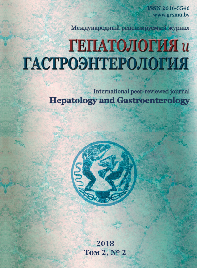THE EFFECT OF ANTIDEPRESSANTS ON BIOCHEMICAL PARAMETERS OF THE BLOOD IN PATIENTS WITH OPIOID DEPENDENCE COMBINED WITH CHRONIC HEPATITIS C
Abstract
Background. Opioid dependence (OZ) accompanied by comorbid chronic hepatitis C (CHC) is a significant medical and social problem in Ukraine. The objective of the study was to analyze the effect of antidepressants (amitriptyline and fluoxetine) on the biochemical parameters of blood serum in drug-addicted patients with low chronic hepatitis C (CHC) activity.
Materials and methods. One hundred and twenty-two patients (98 men and 24 women aged from 21 to 48 years) with opioid dependence (OD) combined with low CHC activity were under the doctor’s care. Group 1 included 64 patients who were prescribed tricyclic antidepressant amitriptyline from 75 mg to 150 mg per day. The patients of group 2 (n = 58) were treated with fluoxetine in a daily dose of 20 to 40 mg in the early withdrawal period.
Results. With dynamic care, it was found that in group 1, when using amitriptyline in patients, the intensity of the cytolytic syndrome significantly increased – the activity of ALAT increased (2.4±0.1 mmol/l*h; Q25-Q75=1.8-2.9; P<0.001 according to Wilcoxon) and ASAT (1.9±0.1 mmol/l*h; Q25-Q75=1.3-2.4; P<0.001 according to Wilcoxon) and these parameters significantly exceeded the parameters of group 2 – ALAT (1.4±0.1 mmol/l*h; Q25-Q75=1.0-1.7; P<0.001 according to Mann-Whitney) and ASAT (0.9±0.1 mmol/l*h; Q25-Q75=0.7-1.4; P<0.001 by Mann-Whitney).
Conclusion. Thus, the use of amitriptyline has a significant effect on the biochemical parameters of cytolysis (P<0.001) and cholestasis (P<0.001) in drug dependent patients with low CHC activity. The use of fluoxetine had almost no effect on the severity of the cytolytic syndrome (FALAT=3.6 (P>0.1); FASAT=4.9 (P>0.1) and moderately increased the activity of cholestasis markers (FGGTP=18.1 (P<0.01); FALP=15.4 (P<0.01). In subsequent studies, it is advisable to develop hepatoprotective therapy using antidepressants in patients with opioid dependence and CHC.
References
1. Sosin IK, Chuev JuF. Narkologija [Narcology]. Harkov: Kollegium; 2005. 800 р. (Russian).
2. Sosin IK, Chuev JuF, Zadorozhnaja TK. Diagnosticheskaja znachimost funkcionalnyh prob pecheni pri narkozavisimyh toksicheskih gepatitah [Diagnostic significance of functional liver tests in drug-dependent toxic hepatitis]. Sovremennye problemy diagnostiki i terapii gepatitov [Modern problems of diagnosis and treatment of hepatitis]. 2000;5(2):128-132. (Russian).
3. Ovcharenko MO, Sosіn ІK, Kazakova SЄ, Pіnskij LL, Ovcharenko TM. Vpliv aktivnostі komorbіdnogo hronіchnogo gepatitu S na neparametrichnі koreljacіjnі zvjazki mіzh koncentracієju prozapalnih citokіnіv ta pokaznikami hemіljumіnescencії sirovatki krovі u hvorih na opіoїdnu zalezhnіst [Influence of the activity of comorbid chronic hepatitis C on nonparametric correlation relations between the concentration of proinflammatory cytokines and the evidence of chemiluminescence of blood serum in patients with opioid dependence]. Zagalna patologіja ta patologіchna fіzіologіja [General Pathology and Pathological Physiology]. 2010;5(1):178-185. (Ukrainian).
4. Seidenberg A, Rosemann T, Senn O. Patients receiving opioid maintenance treatment in primary care: successful chronic hepatitis C care in a real world setting. BMC Infect. Dis. 2013;8:13-19.
5. Ovcharenko MO. Rezultati dispersіjnogo, diskriminantnogo ta kla-sternogo analіzu v ocіncі vplivu aktivnostі komorbidnogo hronіchnogo gepatitu S na bіohіmіchnі pokazniki sirovatki krovі u hvorih na opioїdnu zalezhnіst [Results of dispersion, discriminant and cluster analysis in the evaluation of the effect of comorbid chronic hepatitis C on the biochemical parameters of blood serum in patients with opioid dependence]. Ukraїnskij zhurnal klіnіchnoї ta laboratornoї medicini [Ukrainian Journal of Clinical and laboratory medicine]. 2011;6(1):203-209. (Ukrainian).
6. Billioti de GS, Collin C, Le-Tri T, Pariente A, Bégaud B, Verdoux H, Dray-Spira R, Zureik M. Antidepressants and Hepatotoxicity: A Cohort Study among 5 Million Individuals Registered in the French National Health Insurance Database. CNS Drugs. 2018;32(7):673-684.
7. Elgebaly HA, Mosa NM, Allach M, El-Massry KF, El-Ghorab AH, Al Hroob AM, Mahmoud AM. Olive oil and leaf extract prevent fluoxetine-induced hepatotoxicity by attenuating oxidative stress, inflammation and apoptosis. Biomed. Pharmacother. 2018;98:446-453. doi: 10.1016/j.biopha.2017.12.101.
8. Gahr M, Zeiss R, Lang D, Connemann BJ, Hiemke C, Schönfeldt-Lecuona C. Drug-Induced Liver Injury Associated With Antidepressive Psycho-pharmacotherapy: An Explorative Assessment Based on Quantitative Signal De-tection Using Different MedDRA Terms. J. Clin. Pharmacol. 2016;56(6):769-778.
9. Park SH, Ishino R. Liver injury associated with antidepressants. Curr. Drug. Saf. 2013;8(3):207-223. doi: 102174/1574886311308030011.
10. Sosіn ІK, Ovcharenko MO, Pіnskij LL, Goncharova OJu, Skvira ІM, Chuєv JuF, Burmaka NP, inventors; Harkіvska medichna akademіja pіsljadiplomnoї, assignee. Sposіb prognozuvannja psevdoabstinentnogo sindromu v remіsіjnomu perіodі u pacієntіv na opіoїdnu zalezhnіst [Method of prognosis of pseudoabsentative syndrome in the remission period in patients with opioid dependence]. UA patent 67150. 2012 Feb 10. (Ukrainian).
11. Feng S, He X. Mechanism-based inhibition of CYP450: an indicator of drug-induced hepatotoxicity. Curr. Drug. Metab. 2013;14(9):921-945.
12. Senn O, Seidenberg A, Rosemann T. Determinants of successful chronic hepatitis C case finding among patients receiving opioid maintenance treatment in a primary care setting. Addiction. 2009;104(12):2033-2038.
13. Voican CS, Corruble E, Naveau S, Perlemuter G. Antidepressant-induced liver injury: a review for clinicians. Am. J. Psychiatry. 2014;171(4):404-415.
14. Menshikov VV. Laboratornye metody issledovanija v klinike [Laboratory research methods in the clinic]. Moskva: Medicina; 1987. 368 p. (Russian).
15. Borovnikov VP, Borovnikov IP. STATISTICA – Statisticheskij analiz i obrabotka dannyh v srede Windows [STATISTICA - Statistical analysis and data processing in Windows]. Moskva: Informacionno-izdatelskij dom «Filin»; 1997. 608 p. (Russian).


















1.png)






